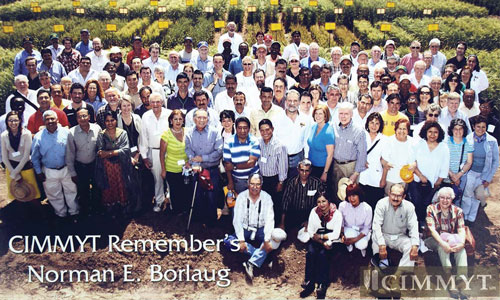Training on conservation agriculture in Bangladesh
 Over 60 researchers, field technicians, farmers, machinery manufacturers, service providers, and extension workers attended two recent conservation agriculture (CA) training events in Bangladesh. The first event was held at the Bangladesh Agriculture Research Institute (BARI) station in Comilla on 28-29 April, followed by an event at the Wheat Research Centre of BARI in Dinajpur on 04-05 May. The events focused on machinery operation and maintenance, as well as the agronomy of dry direct-seeded rice (DSR). Both were part of joint CIMMYT-IRRI efforts to promote sustainable ricemaize systems in collaboration with several national Bangladesh partners.
Over 60 researchers, field technicians, farmers, machinery manufacturers, service providers, and extension workers attended two recent conservation agriculture (CA) training events in Bangladesh. The first event was held at the Bangladesh Agriculture Research Institute (BARI) station in Comilla on 28-29 April, followed by an event at the Wheat Research Centre of BARI in Dinajpur on 04-05 May. The events focused on machinery operation and maintenance, as well as the agronomy of dry direct-seeded rice (DSR). Both were part of joint CIMMYT-IRRI efforts to promote sustainable ricemaize systems in collaboration with several national Bangladesh partners.
At both locations, participants learned about the power tiller operated seeder (PTOS) and the bed former/planter attached with the Chinese-made two-wheel tractor. This equipment is promoted by the project for the rapid establishment of maize, rice, and other crops under CA-based tillage systems such as zero tillage, reduced or minimum tillage, and raised beds. Participants also learned various methods to calibrate seed rates for DSR and decided that fluted roller metering devices with 8 or 16 grooves are the best currently available option for sowing DSR. They also learned basic agronomy for DSR and unpuddled transplanted rice, both of which require the use of the demonstrated machinery.
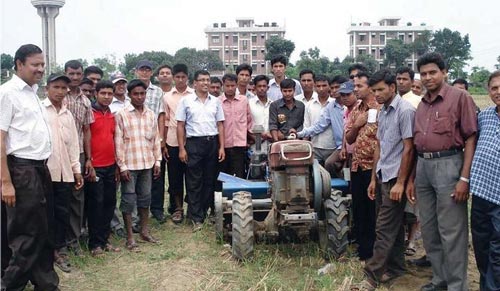 “Machinery operation and maintenance is vital for rapid dissemination of CA-based technologies,” said Jagadish Timsina, IRRI-CIMMYT senior cropping system agronomist. He added that this ACIAR-funded ricemaize project has been adapting and evaluating the PTOS and the bed former/planter at project sites, and has been refining these machines for their use in different soils with the help of agriculture engineers from the national agriculture research intuitions involved in the project. The project has given special emphasis to training and capacity building for machine use and has already trained more than 120 people from government and non-governmental organizations, as well as farmers, service providers, machinery manufacturers, and extension workers since it started in November 2008.
“Machinery operation and maintenance is vital for rapid dissemination of CA-based technologies,” said Jagadish Timsina, IRRI-CIMMYT senior cropping system agronomist. He added that this ACIAR-funded ricemaize project has been adapting and evaluating the PTOS and the bed former/planter at project sites, and has been refining these machines for their use in different soils with the help of agriculture engineers from the national agriculture research intuitions involved in the project. The project has given special emphasis to training and capacity building for machine use and has already trained more than 120 people from government and non-governmental organizations, as well as farmers, service providers, machinery manufacturers, and extension workers since it started in November 2008.
Thanks to those who assisted with and attended these two events, including Israil Hossain and M. Wohab, principal scientific officers and agriculture engineers from BARI who helped in Dinajpur; M. Wohab and A. Rahman, principal scientific officers and agriculture engineers from BRRI who helped in Comilla; T. P. Tiwari, CIMMYT cropping system agronomist and the coordinator of the USAID Famine project; and Timsina.

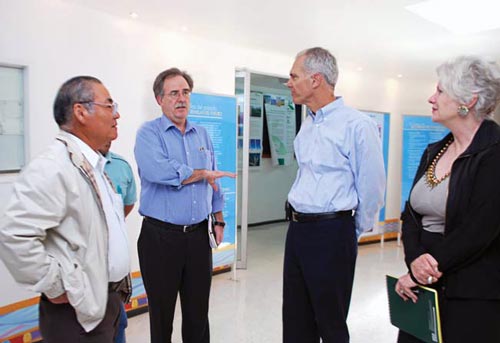 Two members of the new CGIAR Consortium Board, Lynn Haight and Carl Hausmann, visited El Batán during 06-07 May 2010 to meet CIMMYT staff and learn more about the center’s work and culture. Accompanied by CIMMYT Board Chair Julio Berdegué, they toured the facilities and attended general presentations on CIMMYT and on the center’s recently submitted proposals for CG mega programs on maize and wheat. Both said they were happy to visit CIMMYT and impressed with the
Two members of the new CGIAR Consortium Board, Lynn Haight and Carl Hausmann, visited El Batán during 06-07 May 2010 to meet CIMMYT staff and learn more about the center’s work and culture. Accompanied by CIMMYT Board Chair Julio Berdegué, they toured the facilities and attended general presentations on CIMMYT and on the center’s recently submitted proposals for CG mega programs on maize and wheat. Both said they were happy to visit CIMMYT and impressed with the 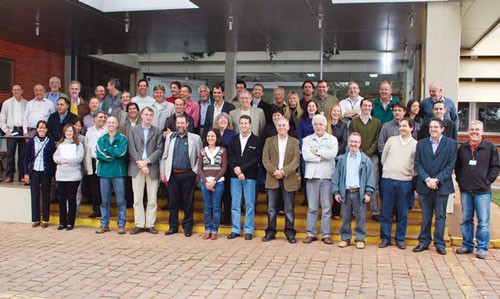
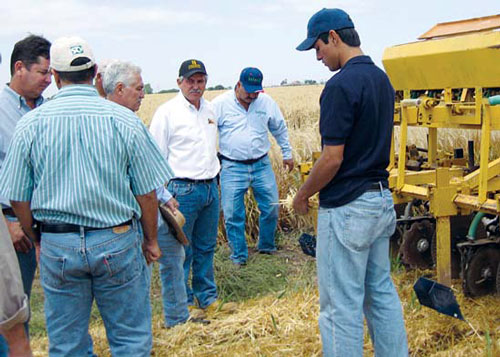 CIMMYT CA experts Jesús Mendoza and Dagoberto Flores led the event, which was the second of what will be a series of monthly CA meeting for local farmers in the Mexican Pacific zone who collaborate with CIMMYT and host CA modules in their land. The expectation is that the meetings will be a venue for farmers to exchange ideas and suggestion to improve their practices. “Conservation agriculture is good and has many advantages,” said farmer Héctor Aguilar, “but we, as farmers, must keep up-to-date on CA.”
CIMMYT CA experts Jesús Mendoza and Dagoberto Flores led the event, which was the second of what will be a series of monthly CA meeting for local farmers in the Mexican Pacific zone who collaborate with CIMMYT and host CA modules in their land. The expectation is that the meetings will be a venue for farmers to exchange ideas and suggestion to improve their practices. “Conservation agriculture is good and has many advantages,” said farmer Héctor Aguilar, “but we, as farmers, must keep up-to-date on CA.” Various research and extensions workers collaborating with the project “Sustainable Intensification of Rice-Maize Systems in Bangladesh” organized five farmer field days throughout March and April 2010. The events took place in the districts of Comilla, Rangpur, and Rajshahi and attracted over 350 farmers.
Various research and extensions workers collaborating with the project “Sustainable Intensification of Rice-Maize Systems in Bangladesh” organized five farmer field days throughout March and April 2010. The events took place in the districts of Comilla, Rangpur, and Rajshahi and attracted over 350 farmers.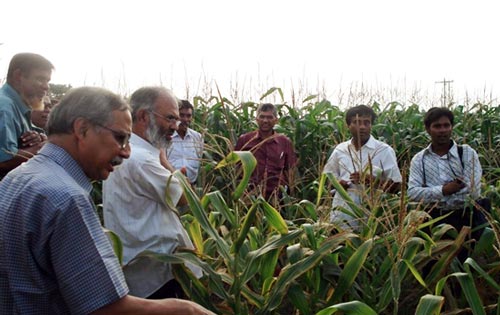 Though the project, which started in November 2008, initially focused on adaptive research in farmers’ fields, it is now starting to emphasize dissemination of improved CA practicies and SSNM technologies to farmers as well. This will be done through training and capacity building with researchers, farmers, extension workers, machinery manufacturers, and service providers.
Though the project, which started in November 2008, initially focused on adaptive research in farmers’ fields, it is now starting to emphasize dissemination of improved CA practicies and SSNM technologies to farmers as well. This will be done through training and capacity building with researchers, farmers, extension workers, machinery manufacturers, and service providers.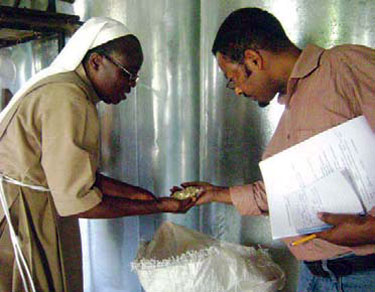 Would you store grain in a metal can? That was the question posed during a humorous skit presented at a stakeholders’ workshop in Homa Bay, Kenya. The can in question is the metal silo and the performance was part of an awareness exercise organized by the Catholic Diocese of Homa Bay. The diocese partners with CIMMYT in the Effective Grain Storage project, where CIMMYT previously facilitated the training of artisans. The project has since continued its work on improved grain storage and creating awareness about the metal silo.
Would you store grain in a metal can? That was the question posed during a humorous skit presented at a stakeholders’ workshop in Homa Bay, Kenya. The can in question is the metal silo and the performance was part of an awareness exercise organized by the Catholic Diocese of Homa Bay. The diocese partners with CIMMYT in the Effective Grain Storage project, where CIMMYT previously facilitated the training of artisans. The project has since continued its work on improved grain storage and creating awareness about the metal silo.